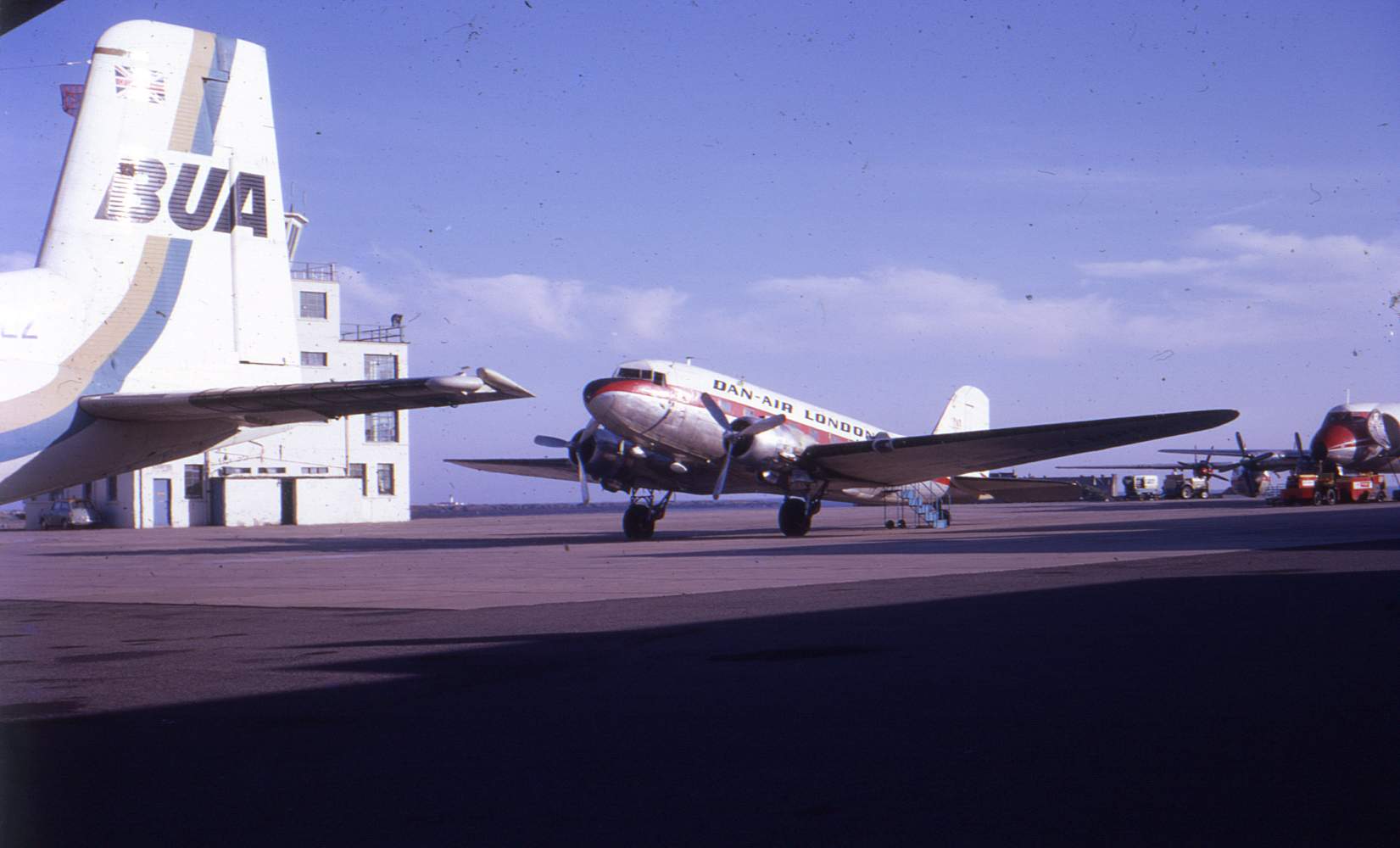Career Highlights 1943 -1972
* Took part in Overlord, June 5th/ 6th 1944, Operation Tonga.
* Flew D-Day resupply mission Rob Roy 1 on June 6th.
* Was piloted by Flight Commander Sqdn. Leader Miller on D-Day but was generally flown by 233 Squadron’s Commanding Officer, Wing Commander Morrison, subsequently Wing Commander Coles & Wing Commander Mellor.
* Led 233 Squadron’s 22 Dakotas towing gliders at Market Garden.
* Flew Arnhem resupply mission on 18th September 1944.
* Dropped supplies to Allied forces near Flushing November 1944.
*Led 24 Dakotas of 233 Squadron on Operation Varsity, Rhine Crossing, March 1945, towing a Horsa glider.
* During surrender negotiations, flew Wehrmacht High Command envoy from Flensburg to Prague to arrange armistice in Czechoslovakia.
* Served with Railway Air Services, BEA during early days of the State airline.
* Joined the Fairey Aviation Group in May 1954 and spent almost 20 years in their service as an aerial survey/ avionics test aircraft.
MILITARY CAREER:
KG313, s/n 12308, was built in Oklahoma City as 42-108846 for the USAAF and delivered on 13th January 1944 (1). Supplied to the RAF under Lend/ Lease, the Dakota III arrived at RAF Dorval, Montreal, on 8th February and is recorded as joining 233 Squadron on March 4th. Given the gap between the two dates, it is possible that KG313 was delivered to 233 at either Gosport or Bircham Newton for service preparation prior to flying to the Squadron’s new home at Blakehill Farm during early March. Familiarisation with the new Dakotas was carried-out during March 1944 at Blakehill and the aircraft were fitted-out for airborne operations.
Training for Operation Overlord commenced during March and continued during April 1944 as further crews arrived from conversion training. Exercises in pannier dropping, paratrooper operations, precision navigation and day/ night formation flying were carried-out using bases such as Netheravon. Glider towing was practiced following the collection of some Airspeed Horsas from Swanton Morley and North Luffenham. Paratroop drops were carried-out at various locations including Netheravon and Stonehenge with the participation of the 1st Canadian Parachute Battalion which had been allocated to the exercises. KG313 would have been prominent in these operations as one of the first Dakotas to arrive and, by April 22nd, up to 22 aircraft were deployed on individual exercises.
(1) From DC3 -the first 70 years by Jennifer Gradidge, Air Britain.
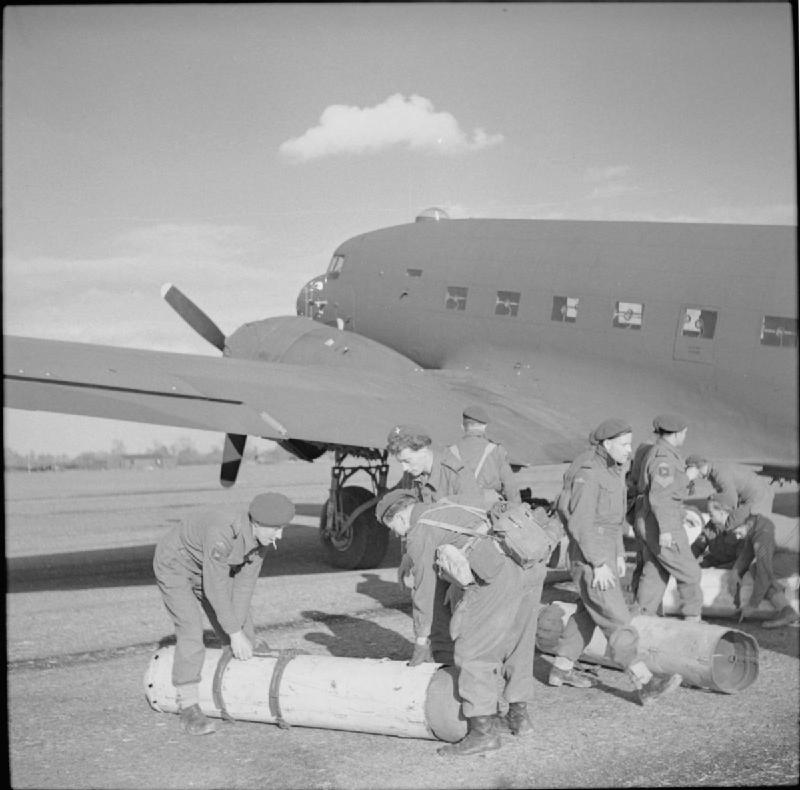
On the night of 25th/ 26th April, 233 Squadron’s first active mission was carried-out with the Squadron CO, Wing Commander Morrison, flying KG341 at the head of a flight of 3 aircraft on a ‘nickelling’ operation to drop propaganda leaflets over France. KG313 was not part of this first mission but possibly took part in subsequent missions leading-up to D-Day, June 6th 1944.
Operation Overlord, D-Day
Following an extensive briefing on June 4th and 5th, Wing Commander M.E.Morrison took to the air at 22:50 on June 5th in Dakota KG424, the first of six 233 Squadron aircraft towing Horsa gliders. KG313, piloted by Squadron Leader B.A.Miller, was airborne at 23:11 leading twenty-four Dakotas carrying paratroops of the 3rd Parachute Brigade. The flight to Normandy went successfully but the drop of troops at ‘K’ DZ was compromised by difficulties with the beacons set by the Pathfinders. KG313 was back at Blakehill Farm at 02:45 on June 6th. The second pilot on this operation, Tonga, was Flying Officer Frank Priestley who would later become a frequent captain of FZ681. Although individual aircraft were not generally assigned to given crews, many aircraft were regularly flown by the same crew. KG313 seems to have had the honour of being chosen by the upper echelons of 233 Squadron. Firstly, Squadron Leader Miller, a Flight Commander flew the Dakota frequently. He went on to lead 233 Squadron briefly between the Wing Commander Morrison and Wing Commander Coles. Both W/C Coles and, subsequently, Wing Commander Mellor generally chose KG313 as their aircraft. Squadron Leaders Pike, Jacklin, Blythe, Daniell and Gillen were also frequently at the controls along with Flt.Lt (later Squadron Leader) A.Mackie.
On June 18th 1944, KG313 flew her first post D-Day mission as part of a 5-aircraft operation to deliver 100 lb bombs to Advanced Landing Ground B2/ Bazenville, Normandy. Squadron Leader Miller captained the crew successfully despite encountering some intermittent flak. The return sector carried 72 stretcher and 18 walking-wounded between the five Dakotas. Three days later, an identical operation involved carrying bombs to France and casualties back to Down Ampney.
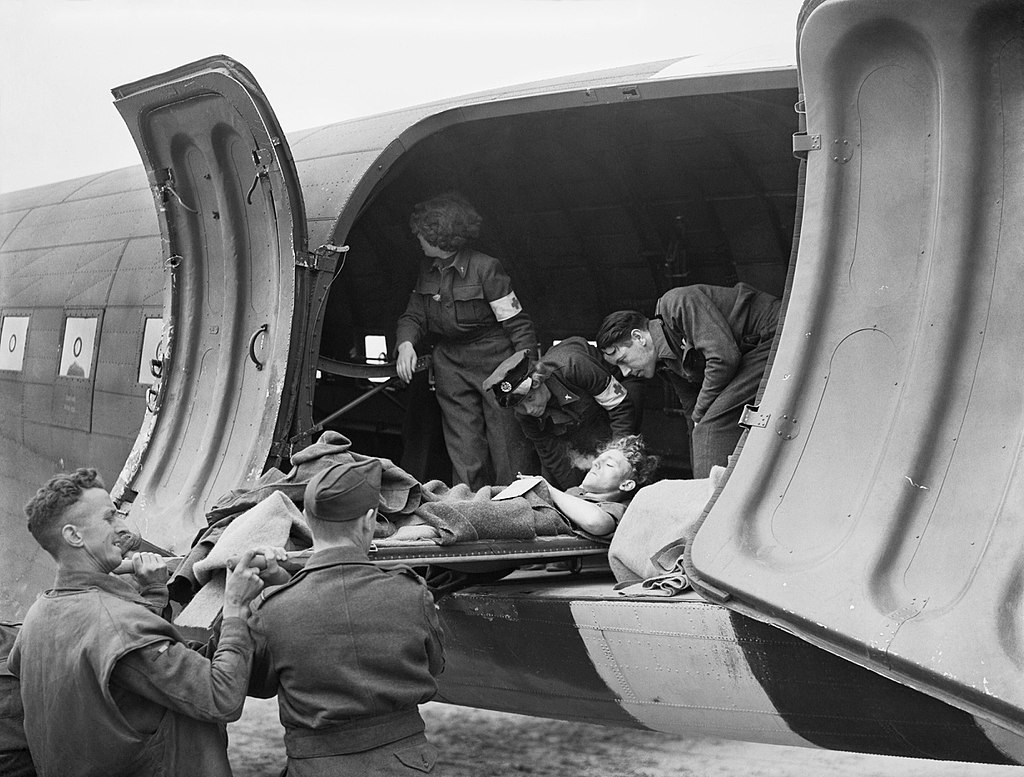
27th June saw Sqdn.Ldr Miller flying KG313 to B2 with (very) varied freight comprising: magazines, guns, spare parts and ‘comforts’. End of the month logs saw Sqdn Ldr Miller signing off as ‘Officer Commanding 233 Squadron’ prior to the arrival of W/C Coles in July.
On July 1st, Sdn Ldr Miller piloted KG313 to B2/ Bazenville with 5000 lbs of radar and signals equipment. The return flight carried casualties and appears to be the last mission flown by KG313 and Miller’s crew during july 1944.
KG313 was back in the air on August 2nd, flown by PO G.Bailley carrying newspapers and medical supplies between Thorney Island and B14/ Amblie before returning with casualties. Two days later, Sqdn Ldr Miller was back at the controls of KG313 for a flight carrying signals equipment from Northolt to B5/ Le Fresne Camilly before returning with further casualties from Amblie. The new Squadron CO, Wing Commander W.Coles, and his crew flew KG313 with passengers and mail to B14/ Amblie on 7th August, again returning with wounded personnel. Sqdn Ldr Miller repeated the operation on August 10th.
The liberation of Paris resulted in a massive food shortage as the German supply lines dried-up. A major allied mission to deliver between 1000 and 2400 tons of food per day was put into action and 233 Squadron was signed-up. The first allied land convoy carrying food entered Paris on August 29th (2); 233 Squadron had flown 24 aircraft carrying supplies to Orleans two days earlier with WC Coles at the controls of KG313. Further 21-aircraft food flights were made to Orleans on 29th and 30th August with KG313 flown by Sqdn Ldr Miller and WC Coles respectively.
(2) Date from Wikipedia.
Wing Commander Coles piloted KG313 on a 2-day operation to A12/ Lignerolles on 4th/ 5th September as part of a fifteen-Dakota mission transferring 40,000+ lbs of 34 Wing equipment from Northolt to the french strip. The hardware on the move belonged to two photo reconnaissance squadrons tasked with supporting the Canadian forces. The Wing Commander’s next flight in KG313 was a petrol delivery flight to B60 on September 10th. This ALG was at Grimbergen, close to Brussels, and illustrated how fast the allies were advancing. Sqdn Ldr Miller’s crew was back in KG313 two days later for another flight carrying fuel and munitions to Grimbergen. Ammunition was , again, the cargo for KG313 on September 13th when Miller’s crew made a twin-delivery to B58/ Brussels-Melsbroek. FZ681 and KG313 remained at Brussels overnight before proceeding to B48/ Amiens the following morning to collect passengers for B56/ Brussels-Evere. Casualties were carried on the final sector back to England. Upon arrival at Blakehill Farm, the Dakota joined the other aircraft being prepared for glider-towing duties scheduled for later that week.
Operation Market Garden on September 17th saw Wing Commander Coles taking off at 09:55 in KG313 at the head of twenty-two 233 Squadron Dakotas towing Horsa gliders carrying the British First Airborne Division to Arnhem. KG313 landed back at Blakehill Farm at 15:30. The Dakota was back in action the following day when Sqdn Ldr Miller’s crew was part of a sixteen aircraft resupply mission. However, KG313 was fortunate that WC Coles flew a different Dakota, KG559, on the resupply mission on September 21st. Anti-aircraft fire was effective and several Dakotas were hit by flak. KG559 suffered holes in both wings, damage to the elevators and injury to the Wireless Operator. WC Coles landed at B56/ Brussels Evere rather than attempt returning to Blakehill.
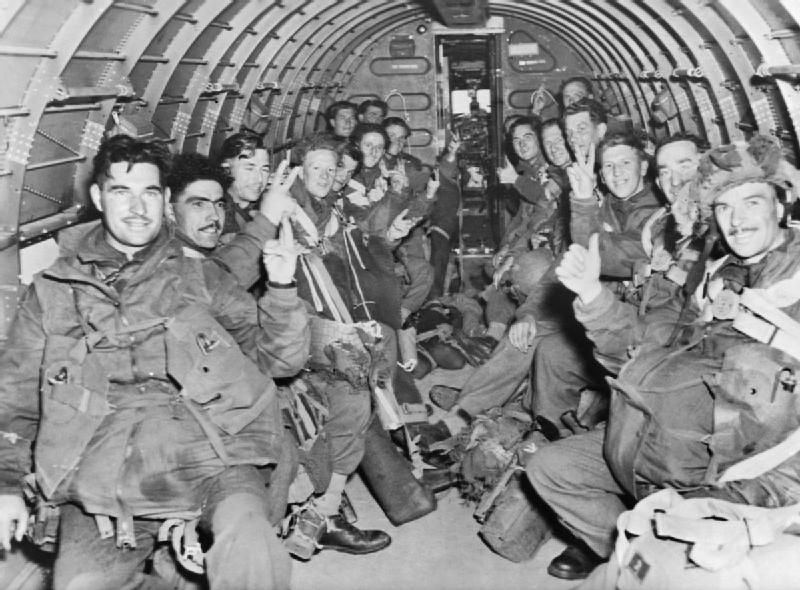
Transport missions were flown for the remainder of the month: WC Coles was one of five aircraft carrying stretchers and blankets to B56/ Brussels-Evere on 20th and 25th September while PO G.Bailey transported ammunition to B58/ Melsbroek on 26th before collecting further casualties from B56/ Evere. PO Bailey’s crew carried Typhoon drop tanks to B59/ Ypres on the morning of September 27th and, the same evening, WC Coles took KG313 as one of eleven aircraft positioning to the Norfolk airfield of Matlaske. The following day, the transports delivered personnel to B60/ Grimbergen before returning to Blakehill Farm via Matlaske.
October operations were mostly in support of the advancing allies:
2nd October: WO Green flew KG313 as part of 17 Dakotas carrying petrol to B56/ Evere, returning to Down Ampney with wounded.
3rdOctober: WO McCrae took 2000 lbs freight to B6/ Coulombs, returning with cargo.
4th October: FO White flew KG313 as part of 14 aircraft armada taking ammunition to B56/ Brussels-Evere.
6th October: WO Green, 12 aircraft mission to B56, returning to Broadwell with wounded soldiers.
7th October: FO White took mail to B56 and onwards to B17/ Caen, home to base.
11th October: WO Curtis, 9 aircraft mission, lubricating oil to Evere, returning to Manston.
14th October: FO Hunter piloted KG313 on a 6-aircraft mission to B56/ Evere carrying army hardware such as tank tracks and ordnance.
16th October: A similar mission, one of four aircraft carrying shells and tank tracks to B58/ Melsbroek. Along with FZ678, returned to Down Ampney with 36 stretchers and eight walking wounded.
19th October: FO Hyne, 15 Dakota mission to B70/ Antwerp carrying ammunition, returning empty.
21st October: WO Evered flew a near-identical mission as part of an eleven-aircraft complement.
22nd October: FO Dober ferried 4998 lbs of mail to B58/ Brussels-Melsbroek, carried documents on to B17/ Caen then returned to Brussels with 2195 lbs of mail and, subsequently returned to base.
26th October: FO Menzies crew took KG313 to B78/ Eindhoven as part of a 5-aircraft operation delivering clothing. The Dakota returned to Blakehill with officers’ and personnel kit.
29th October: FO Colman, four aircraft carrying freight to B78/ Eindhoven, returning to Down Ampney with stretchers and sitting wounded.
30th October: FO Hyne, one of ten aircraft carrying clothing and maps to B70/ Antwerp.
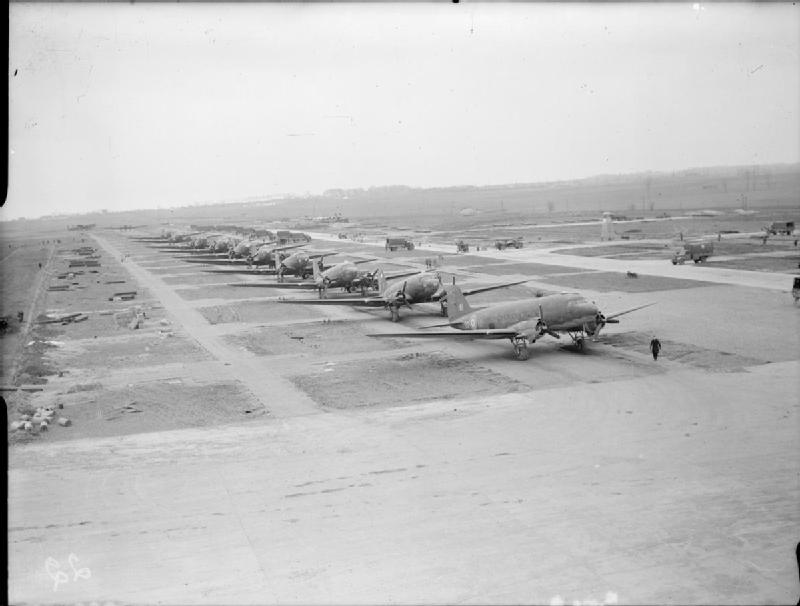
November 1944 started with KG313, piloted by Sqn Ldr T.W.Gillen, carrying passengers from Northolt to B58/ Melsbroek on 1st of the month, returning the following day to Blakehill Farm with 12th Airborne personnel. The Squadron OC, WC Coles, was back at the controls the next day as part of a 4-aircraft operation carrying mattresses and wireless equipment to Brussels-Evere before returning with jeep trailers and more passengers.
A mail run on 4th took 2958 lbs of letters and 960 lbs of freight to B17/ Caen-Carpiquet and then lifted 2500 lbs of mail and three passengers to B58/ Melsbroek before returning to base with fourteen aircrew. KG313’s next flight was on November 6th and marked a brief return to active operations in support of allied forces trying to mop-up German forces around Flushing. Ninety-six panniers were loaded at Blakehill Farm onto the six aircraft participating before they flew to B70/ Antwerp. The short mission to drop the panniers onto a beach north-west of Flushing went well and all aircraft returned to Antwerp safely before staging back to Blakehill Farm.
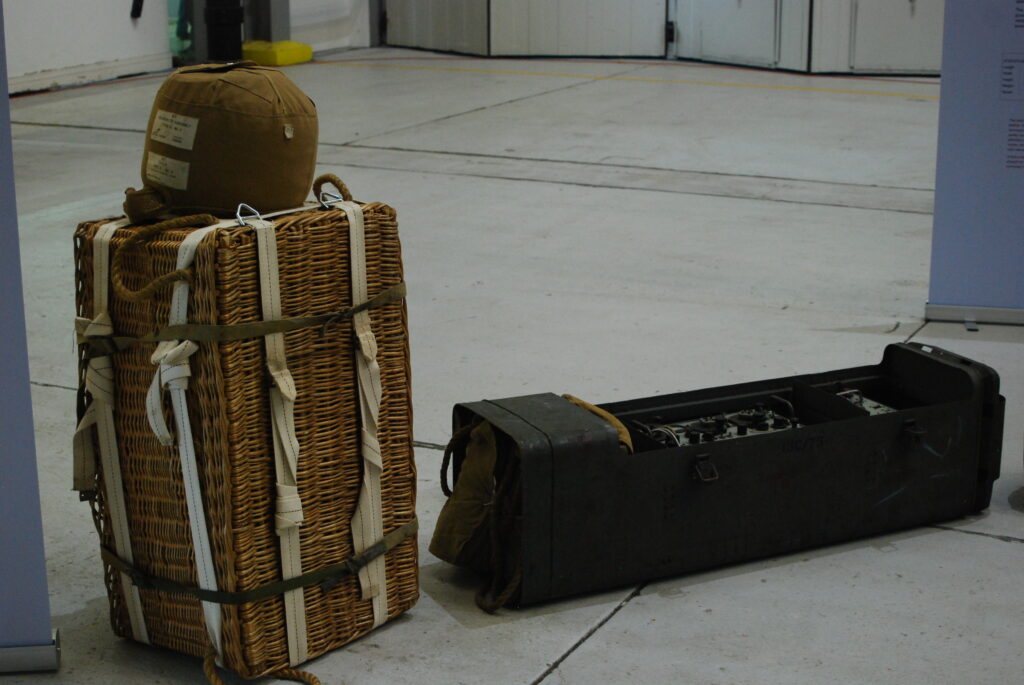
Wing Commander Coles piloted KG313 outwards from Northolt to B58/ Melsbroek on 7th November with 20 passengers and their kit, returning the following day with thirteen Northolt-bound passengers. A similar mission ensued on 9th November with Sqdn Ldr Gillen piloting KG313 carrying 19 VIPs from Northolt to B58/ Brussels, returning on 10th with 12 VIPs destined for Northolt and one for Blakehill.
There then appears to have been around 10 days break in operations for KG313 – probably reflecting training flights or maintenance. FO Chambers crew flew 23 passengers and their kit from Northolt to B78/ Eindhoven and B58/ Brussels- Melsbroek on 24th November. KG313 remained at the Belgian airfield overnight before retracing her steps to B78/ Eindhoven and B70/ Antwerp with passengers bound for Fairwood Common. Returning to Blakehill Farm, the Dakota performed a similar mission on 26th November when the new CO of 233 Squadron, Wing Commander Mellor, again selected KG313 for a passenger flight from Northolt to Melsbroek. Twenty passengers were returned to Northolt the following morning. The Wing Commander then took KG313 to B77/ Gilze-Rijen with munitions on 29th November as part of a 7-aircraft mission. The Dakotas returned to Blakehill ready to participate in glider-towing training the following day.
December 1944 started with a 10-aircraft lift carrying ammunition to B58/ Melsbroek on 1st. Sdn Ldr Gillen took-off from Blakehill at 09:16, unloaded at Brussels and then embarked personnel and kit for Perranporth in Cornwall. The Dakota was back at base by 18:00. WC Mellor was at the controls again the following day for an eight-aircraft mission carrying army freight to B77/ Gilze-Rijen. The Wing Commander also flew KG313 on her subsequent mission when, on December 4th, she was one of three Dakotas carrying maps and miscellaneous stores to B58/ Melsbroek, returning with walking casualties to Broadwell. The remainder of the month saw KG313 flying on most days:
5th December: PO White’s crew carried 15 passengers and kit from Warmwell to Melsbroek and 14 passengers back to Northolt.
7th December: Sdn Ldr Gillen piloted KG313 as one of three Dakotas carrying RAF stores from Bicester to B58/ Melsbroek, returning to base with eleven walking wounded and one passenger.
8th December: WC Mellor, Flt.Lt Johnstone and Flt.Lt. Frew operated KG313 as one of nine aircraft carrying freight to B77/ Gilze-Rijen.
9th December: FO Smith lifted at 11:00 with freight for A54/ Le Bourget before returning empty.
11th December: WC Mellor took-off at 08:10 en route to B58/ Melsbroek with 5000 lbs of tank spares before returning to Down Ampney with eleven passengers.
12th December: Sdn Ldr Jacklin flew KG313 in a large 14-aircraft mission carrying ammunition to B77/ Gilze-Rijen.
17th December: KG313 again flew army stores to B77/ Gilze-Rijen, with WC Mellor leading ten 233 Sqn Dakotas.
18th December: Sqdn Ldr Jacklin’s crew flew KG313 as one of five aircraft carrying RAF freight to B58/ Melsbroek before returning empty.
22nd December: WC Mellor piloted KG313 as one of five aircraft carrying mail to and from B58/ Melsbroek.
23rd December: Flt.Lt Mackie’s crew carried army freight to B58, returning empty.
24th December: On Christmas Eve KG313 and WC Mellor carried 5000 lbs of SHAEF stores to A54/ Le Bourget, returning with 16 passengers.
26th December: WC Mellor took KG313 as part of a 10 aircraft mission carrying US troops from Beaulieu to A83/ Denain-Valenciennes, returning via a 2-night stop at Holmesley South.
31st December: On the last day of 1944, WC Mellor and his crew of Flt.Lt A.Johnstone and Flt.Lt Frew traveled in KG313 to B79/ Woensdrecht as part of a 3-aircraft flight carrying 33 passengers.
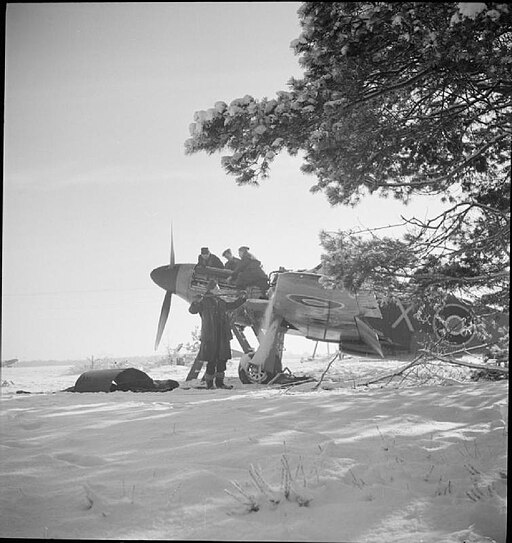
1945:
FO Dober flew KG313 with mixed freight to B58/ Melsbroek on 3rd January before returning to Down Ampney with mail. The following day, WC Mellor lifted-off from Northolt bound for Brussels with the Scotland football team. The flight had to return to Northolt owing to bad weather. KG313 was on another passenger mission on 5th January with Sqdn Ldr Jacklin carrying 20 (possibly the football team) to Melsbroek. The return leg carried thirteen passengers and their baggage. Sqdn Ldr Jacklin was also at the controls the following day as part of a 4-aircraft mission delivering 20,000 lbs of spares to B75/ Nivelles. The Allied airfields around Brussels and other Belgian locations had suffered intensive Luftwaffe attacks during the early part of January as part of ‘Operation Bodenplatte’, an airborne equivalent of the Battle of the Bulge.

After a few days break, Flt.Lt Mackie’s crew flew KG313 to melton Mowbray with four other Dakotas on January 18th. Weather then delayed the departure for A54/ Le Bourget with passengers and equipment until the following day. Four of the Dakotas returned to Blakehill empty but KG313 carried 2500 lbs of signals equipment. On January 21st, three Dakotas carried 15,000 lbs of spares to B78/ Melsbroek, with KG585 and WC Mellor, in KG313, returning to Down Ampney with 36 stretcher cases and walking wounded. The next day, 22nd, saw Flt.Lt Mackie, flying KG313 in the company of a second Dakota, taking Tempest drop tanks to B75/ Brussels-Nivelles before returning to Down Ampney with 1700 lbs of cipher equipment and one passenger.
On 26th January, Flt. Lt Mackie was back in KG313 carrying 5000 lbs of RAF freight to B58/ Melsbroek. After a night-stop, they returned to Blakehill Farm with eighteen USAAF air crew. 28th January saw WC Mellor in command of KG313 taking part in a six-aircraft mission carrying emergency army freight to B75/ Nivelles. A final operation for KG313 in January saw Flt.Lt Mackie flying 5000 lbs of supplies for Airborne forces to B75, returning to Northolt with 23 passengers.
February 1945 saw 233 Squadron heavily involved in moving personnel and freight to the continent ahead of the Spring offensive. On 1st February, WC Mellor flew KG313 as one of eight aircraft delivering mixed army freight to Brussels Nivelles. Sqdn Ldr Pike flew KG313 on a near-identical mission on 3rd February as part of a 12-aircraft operation. On 4th February, the Wing Commander flew the Dakota from RAF Wing to A68/ Juvincourt with 4500 lbs of RAF stores. The following day, Flt.Lt Mackie took KG313 from Thorney Island to B87/ Rosieres-en-Santerre in the company of seven other aircraft carrying a total of 152 personnel from #140 Wing. The next day, Flt.Lt Mackie’s crew returned to B87 in KG313 as part of a 4-aircraft operation transporting 73 RAF personnel from Thorney Island. On February 7th, WC Mellor took the Dakota on a 6-aircraft mission to Brussels-Nivelles carrying 35,000 lbs of army freight. The next day, February 8th, involved no operational flying as the Squadron practiced glider-towing operations, but WC Mellor returned to B75/ Nivelles on February 9th carrying 160 troops between 8 Dakotas. A similar operation to Brussels on 11th involved WC Mellor’s crew and KG313 shuttling troops to Belgium. Then there was over a week’s break for KG313 before a return to Nivelles carrying spares on February 20th. Flt.Lt Mackie was at the controls for the homebound sector carrying ‘distressed aircrew’ back to Down Ampney. Passengers were on the roster the following day, February 21st, when WC Mellor flew from Blakehill Farm to Northolt to collect customers outbound to B75/ Nivelles. The return leg also landed at Northolt to deliver passengers.
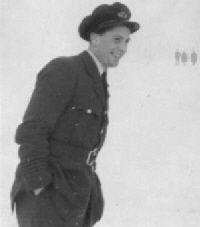
The end of February 1945 involved KG313 flying every day between 22nd and 28th, largely on operations moving troops to and from B75/ Brussels-Nivelles. On 22nd, Flt.Lt Barlay’s crew operated a double-header, flying from Blakehill to B75 as part of an operation to return 217 troops to netheravon before returning to Brussels for another 219 troops heading for Blakehill Farm. The next day, Flt.Lt Mackie piloted KG313 as one of nine Dakotas taking panniers and parachutes to B75, returning with almost 180 troops of the 6th Airborne Division. WC Mellor flew a very similar mission with KG313 on 24th, firstly as one of ten aircraft taking troops and panniers to Brussels and returning with 6th Airborne troops and, secondly, as one of seven Dakotas collecting a further 140 or so troops from the Continent. Flt.Lt Mackie flew in a further 10-aircraft freight flight to B75/ Nivelles on 25th, again returning with troops. There was some variety on 26th, when WC Mellor flew KG313 to Colerne to pick-up freight and six passengers destined for B56/ Brussels-Evere, returning via the USAAF base at Honington with twenty American airmen. Flt.Lt Barlay was also on a single-aircraft mission on 27th, delivering urgent spares to A54/ Paris Le Bourget before returning with 4000 lbs of synthetic rubber. The final flight of the month was flown by Flt.Lt Barlay as part of a six-aircraft group delivering parachutes to B75/ Brussels Nivelles before flying on to B65/ Maldegem to uplift stretcher-bound and walking wounded destined for Down Ampney.
The early part of March 1945 continued to be a busy period for KG313 in the lead-up to Operation Varsity. The first week comprised multiple passenger missions:
1st March: WC Mellor flew 27 passengers from Northolt to B75/ Nivelles, night-stopping and returning empty to Blakehill.
3rd March: Flt.Lt Mackie flew 21 passengers to A54/ Paris LeBourget, probably from Northolt (it looks like Nuneaton in the log!).
4th March: WC Mellor carried 16 personnel of #85 Group from Northolt to B51/ Lille before returning to Northolt with 20 passengers.
6th March: Flt.Lt Mackie delivered 20 Canadian troops to B75/ Brussels-Nivelles before returning to Northolt with passengers.
7th March: WC Mellor piloted KG313 as one of three aircraft taking 46 personnel of #121 Wing from RAF Warmwell to B80/ Volkel before returning to Warmwell with further passengers.
8th March: Flt.Lt Mackie flew KG313 as one of ten aircraft positioning to Greenham Common before returning to Blakehill with medical supplies and blankets. On te following day, Flt.Lt Mackie flew 5000 lbs of the medical supplies to A93/ Liege before transiting to B80/ Volkel to collect 5000 lbs of tool kits bound for Warmwell.
12th March: Flt Lt Mackie flew KG313 as part of a 12-aircraft armada taking army freight to B75/ Nivelles.
15th March: Flt.Lt Mackie’s crew traveled to Perranporth, Cornwall, to collect equipment for B56/ Brussels-Evere. Two days later, they delivered drop tanks to B75/ Nivelles before returning to Farnborough with three stretcher-cases and four walking wounded. A return to base was made via Warmwell.
18th March: Flt.Lt Mackie was at the controls of KG313 as one of ten Dakotas delivering 151 RAF personnel and 4500 lbs of baggage to B86/ Helmond. The aircraft continued empty to B78/ Eindhoven where 166 RAF personnel were embarked for Warmwell.
20th March: WC Mellor and his crew, Flt. Lt Frew, Flt.Lt Johnstone and Flt.Lt E.J.Sharpe, lifted at 06:25 as one of fourteen aircraft headed to Perranporth to transfer 133 personnel and kit to B56/ Evere. The Dakotas returned to base empty to prepare for Operation Varsity.
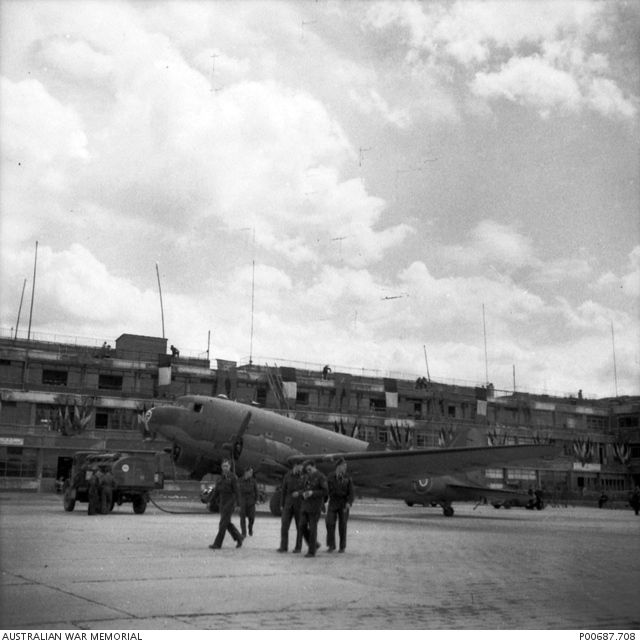
233 Squadron positioned to RAF Birch airfield in Essex on March 21st with the 26 aircraft led by WC Mellor in KG313. After two days of briefing and preparation, the 24 Dakotas taking part in Varsity took to the air on the morning of March 24th, each towing a Horsa glider, carrying a total of 357 troops of the 2nd Oxfordshire and Buckinghamshire Regiment. Wing Commander Mellor DFC led the take-off in KG313, lifting-off at 06:18, and all aircraft were airborne by 06:49. After a steady flight to the target (near Wessel), the gliders were successfully released between 10:17 and 10:21 and all but one of the Dakotas proceeded to B75/ Brussels-Nivelles to refuel.
The Dakotas remained on the ground at Nivelles pending a resupply mission but this was not considered necessary and they returned to Blakehill Farm on March 25th. The following day, Flt.Lt Mackie recommenced logistics missions flying KG313 on two trips from base to B75/ Nivelles with cluster bombs. Eighteen stretcher cases and six walking wounded were repatriated to Down Ampney on the second flight.
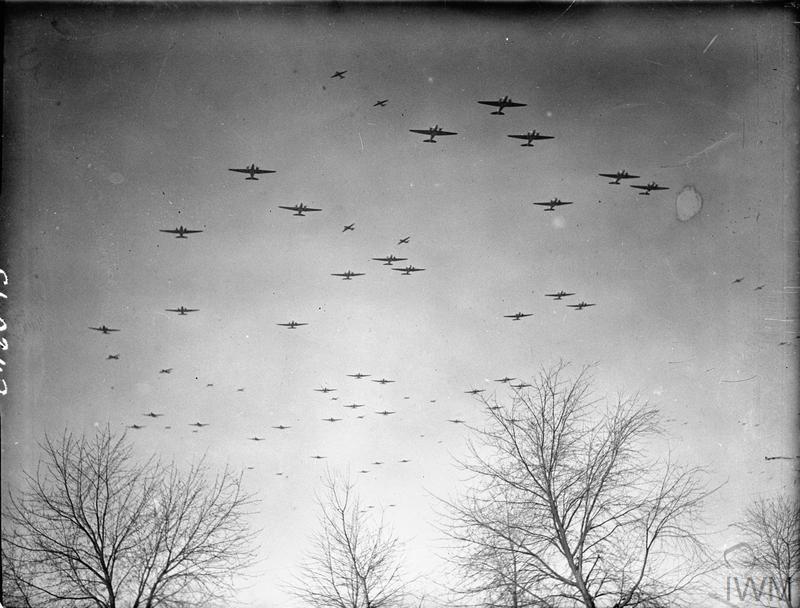
WC Mellor performed a brief run to A54/ Paris Le Bourget in KG313 with 4500 lbs of RAF freight on 27th March. Bad weather, intervened on 28th but, on 29th March, Flt.Lt Mackie flew KG313 to B75/ Nivelles with 5000 lbs of spares. The Dakota then transited to B100/ Goch, its first destination inside German borders (just), to pick-up 18 stretcher cases and 12 walking-wounded for transfer to Brussels-Evere where there was an allied military hospital. A second rotation to B100 collected 22 stretcher cases and transferred them to Down Ampney. WC Mellor was back at the controls on March 30th for a leisurely 10:10 take-off to deliver 4800 lbs of spares to B50/ Vitry-en-Artois. On March 31st, the promoted Squadron Leader Mackie positioned KG313 from Blakehill to Broadwell to collect RAF freight for B75/ Nivelles. the return flight carried 17 aircrew to RAF Honington.
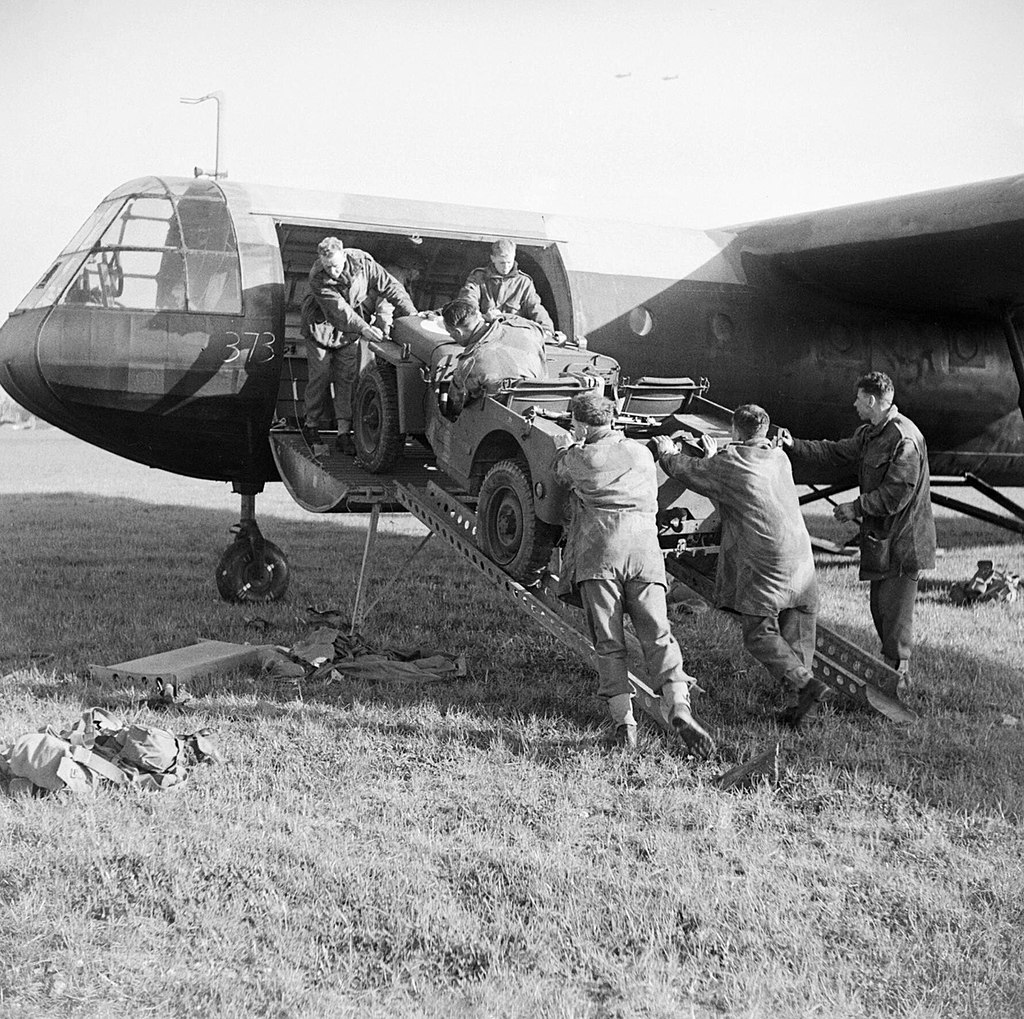
With the stop of glider towing and pannier dropping exercises during April 1945, the volume of logistics operations stepped-up in support of the allies final advance into Germany. KG313’s first load of the month comprised drop tanks delivered to B75/ Nivelles on April 1st. WC Mellor was back in command the following day for an eight-aircraft lift of passengers and kit from Fairwood Common to B85/ Schijndel in the Netherlands. Sqdn Ldr Mackie DFC and his crew delivered 5000 lbs of army freight to A54/ paris Le Bourget on April 3rd and returned to base with four aero engines. WC Mellor led five aircraft on the 20 minute hop to Netheravon on April 4th. Embarking 101 troops, the five Dakotas proceeded to Y55/ Venlo on the Dutch/ German border and then continued to B56/ Brussels-Evere where they collected stretcher-borne and walking wounded for transport to Down Ampney. Four days later, on April 8th, WC Mellor flew KG313 to Earls Colne in Essex to collect 15 SAS soldiers bound for B56/ Brussels-Evere. Eighteen stretcher cases and six walking-wounded were carried on the return sector to Down Ampney. As well as personnel, the outbound flights also included fuel and, on April 9th, WC Mellor, flying KG313, led twelve Dakotas on a fuel-delivery mission from Greenham Common to Y85/ Ettinghausen in Germany. Former POWs were carried to RAF Wing on the return leg.
On April 10th Flt.Lt Barlay had an individual mission collecting eighteen passengers from Perranporth and delivering them to B75/ Nivelles. From there, KG313 flew to B65/ Maldegem to collect fourteen stretcher cases bound for Down Ampney and one passenger heading to Blackbushe. A new name, Flt. Lt. W.Hunter, took KG313 to Greenham Common the following day as part of an eleven-aircraft mission delivering petrol from Greenham to Y87/ Nidda. From there, the aircraft positioned to Y30/ Ophoven to collect ex-POWs bound for Westcott. A similar mission was flown by WC Mellor the following day, April 12th, when three Dakotas delivered spare parts to A54/ Le Bourget before picking-up more ex-POWs from Ophoven and transporting them to RAF Wing. 13th April saw WC Mellor on another similar mission in KG313 leading six aircraft carrying petrol to B108/ Rheine in Germany before collecting ex-POWs from Y83/ Limburg and transferring them to RAF Wing. FO Smith’s crew were allocated to KG313 on April 14th and departed Blakehill Farm at 10:40 carrying aircraft spare parts to B108/ Rheine, transiting to B56/ Brussels and collecting 29 walking casualties before returning to base via a fuel stop at RAF Ford. Squadron Leader Blythe DFC flew KG313 alongside FZ680 to B108/ Rheine with a cargo of Merlin engines on April 15th. The aircraft positioned to B91/ Kluis in Holland and returned to Woodbridge, Suffolk, with 38 troops. WC Mellor took an empty KG313 to Perranporth on 16th April, loaded 6 passengers and three motorcycles and flew them to B56/ Brussels, apparently via Blakehill and A54/ Le Bourget. KG313 was then flown to Redhill with 14 casualties and five passengers and on to Down Ampney with 6 stretcher casualties. returning to Blakehill, KG313 was then readied for an 09:15 lift to B118/ Celle, Germany, with 5016 lbs of petrol on April 15th. Sqdn Ldr Mackie then flew on to B91/ Kluis, Holland, to embark 26 ex-POWs destined for Brussels-Evere before returning to Celle with a further 5016 lbs of fuel. Fourteen casualties returned to B56/ Brussels-Evere and 26 ex-POWs picked-up for transport to Westcott.
After a brief pause, KG313 was flown to Helmstedt on 21st April with a spare wheel. Squadron Leader Blythe’s crew handed over the Dakota to FO Smith and returned to Blakehill on a different aircraft. FO Smith departed Helmstedt at 12:00 en route to B114/ Diepholz where 18 stretcher cases and 8 walking wounded were embarked for the flight back to Down Ampney. The next morning, 22nd April, KG313 lifted from Blakehill Farm at 09:43 on a multi-leg mission to the Continent. Sqdn Ldr Blythe was back at the controls and petrol was the cargo on the first sector, again to B114/ Diepholz. From there, KG313 carried ex-POWs to B77/ Gilze-Rijen and transited empty to B100/ Goch. Ammunition was then transported back to Diepholz before the Dakota positioned empty to R14/ Detmold to collect ex-POWs bound for Wing. The aircraft was back at Blakehill at 00:15 on April 23rd ready for the next circuit. This time it was Sqdn Ldr Mackie in command for a fuel flight to B118/ Celle followed by an empty sector to R35/ Volkenrode where 25 ex-POWs were collected for transfer to B56/ Brussels. The return leg to RAF Wing carried 30 ex-POWs. Similar operations followed almost every day until the end of the month:
24th April: FO Wright commanded KG313 on a petrol flight to B114/ Diepholz, returning to Dunsfold with ex-POWs.
25th April: Sqdn Ldr Daniell DFC AFC piloted KG313 on an identical trip.
26th April: FO Diamond flew KG313 as one of six Dakotas taking petrol to B118/ Celle, continuing to B114/ Diepholz to collect ex-POWs and casualties bound for B56/ Brussels-Evere. The next leg took kerosene to B152/ Fassberg followed by an empty sector to B108/ Rheine where French ex-POWs were uplifted for travel to B56/ Brussels. Returning empty to Blakehill Farm, bad weather interfered with the next day’s 12-aircraft operation, a petrol lift to B114/ Diepholz. Sqdn Ldr Daniell returned to Wing with ex-POWs after a delay in Germany.
30th April: KG313, flown by Flt.Lt Hunter took ATS and RAF personnel to B56/ Brussels and night-stopped. The following day, May 1st, KG313 transported paraffin on the next sector, then flew to R14/ Detmold to uplift ex-POWs destined for B56/ Brussels. The Dakota then flew on to B103 (or B105?) to collect 17 passengers bound for Fairwood Common.
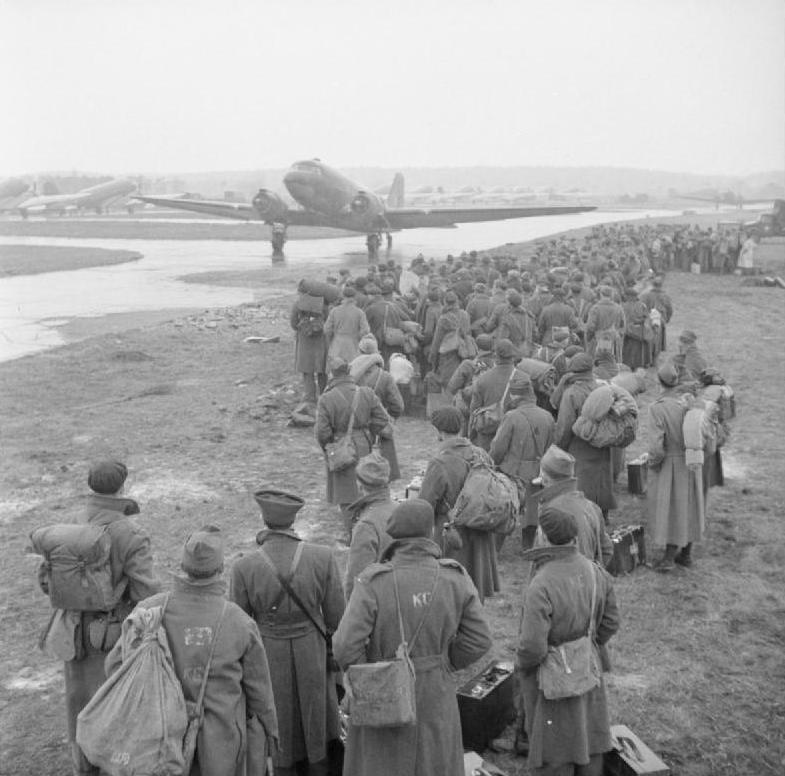
As the end of WW2 approached, logistics missions via the Brussels airfields continued apace for KG313. Sqdn Ldr Blythe’s crew took to the air at 09:15 on May 4th en route to B56/ Brussels Evere with 5000 lbs of army freight. A full load of freight was carried to B114/ Diepholz before the Dakota was flown to B108/ Rheine (interpretation of destination from logs not guaranteed) to collect 20 ex-POWs bound for B56/ Evere. Thirty ex-POWs were then flown to Y30/ Le Havre, the hub for repatriating ex-prisoners. Thirty further ex-POWs were then flown to RAF Westcott before KG313 returned to Blakehill. The following day, May 5th, Flt Lt Barlay collected 5000 lbs of oil from Broadwell, but the mission was recalled owing to poor weather.
KG313 took part in some of the historic flights which took place as part of the formal surrender of Germany. FO Diamond and his crew departed Blakehill on May 7th with 5000 lbs of freight for B118/ Celle. From here, they were routed empty to B156, the airfield at Luneburg, the town that Field Marshall Montgomery had made his headquarters. Passengers and fuel were uplifted for the short hop to Flensburg. Following the suicide of Hitler, the remnants of the Third Reich had decamped from Berlin to the Naval College at Flensburg. From here, the new ‘Fuhrer’, Admiral Doenitz, attempted to negotiate a conditional surrender with the western allies: he was out of luck. Some parts of the Wehrmacht continued to fight and, in particular, the garrison at Prague, Czechoslovakia, was resisting the Russian advance with the danger that the city could be destroyed. KG313 collected Colonel Meyer-Detring, a German High Command envoy, from Flensburg and flew south to Pilsen airfield, close to Prague. The Dakota waited at Pilsen while the Colonel was transported into Prague to inform the German commander that he should surrender.The envoy’s three-man team returned to Pilsen the following morning, May 8th, and KG313 took off on the return flight to Flensburg via Luneburg. The Russians successfully entered the Czech capital the following day, May 9th. Meanwhile, KG313 arrived at Flensburg by midday on May 8th, the day that WW2 finished in Europe. Without taking time for VE Day celebrations, the Dakota was soon in the air again, heading for Copenhagen with 7 SHAEF passengers. The surrender of German forces in Copenhagen had formally taken place on May 5th and the Supreme Headquarters of the Allied Expeditionary Force (SHAEF) had installed a British general as interim authority until the return of the Danish King. KG313, meanwhile, returned empty to Blakehill Farm on 8th.
On May 10th, FO Wright flew KG313 to B56/ Evere and then on to B114/ Diepholz with blankets. A return was made to B56 with ex-POWs before the circuit was repeated; blankets to Diepholz, ex-POWs to Evere. The next leg was with freight to B154/ Reinsehlen before traveling empty to Diepholz to collect another 35 ex-POWs for Brussels. The next sector was back to B154, again with freight, followed by the lift of four passengers to Diepholz and then five passengers back to Westcott.
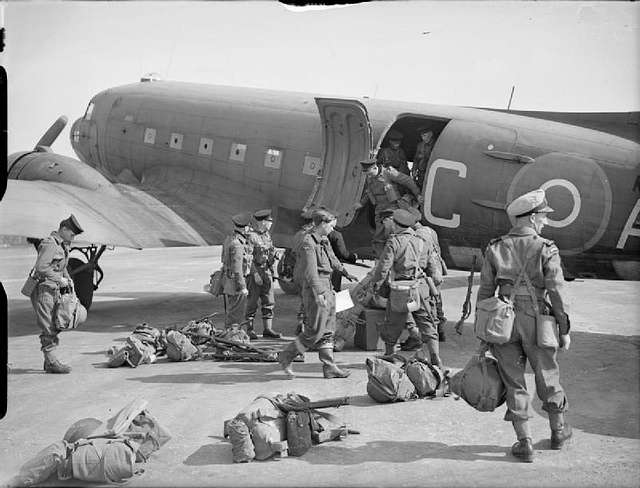
Wing Commander Mellor resumed control of KG313 on May 12th for a flight carrying 5000 lbs of freight to B78/ Eindhoven. Continuing empty to B56/ Brussels-Evere, freight was collected for B118/ Celle prior to an empty stage to B158/ Lubeck. Twenty-six ex-POWs were picked-up at this German airfield and returned to B56/ Brussels. KG313 returned to Blakehill Farm prior to her next mission the following day. Flt.Lt Lew Cody operated three missions empty to B56/ Brussels-Evere, returning with 30 ex-POWs bound for Dunsfold on flights one and two and Wing on the last flight. WC Mellor flew KG313 on May 14th, leading 18 aircraft transporting troops from Matching. Departing Blakehill at 06:10, the 29 soldiers were picked-up and delivered to B56/ Brussels. KG313’s first return flight carried 24 ex-POWs to Oakley before returning to B56 to collect 30 ex-POWs for Tangmere. The third flight duplicated the second. The same operation was carried-out on May 15th with Sqdn Ldr Daniell’s crew making two flights from Matching to B56, returning to Dunsfold with ex-POWs.
There was a geographical expansion of operations for KG313 on 16th May 1945 when WC Mellor flew to Boreham in Essex to collect equipment and mail bound for Norway. With a 5000 lb payload, the flight to Oslo required a fuel stop at Sumburgh in the Shetland Islands. The flight returned from Oslo empty via Copenhagen to B118/ Celle. The following day, May 17th, 22 passengers were flown from Celle to Croydon before the Dakota hopped back to Blakehill Farm. Sqdn Ldr Blythe was the next to captain KG313, flying 11 passengers from Croydon to B56/ Brussels on May 21st. From Brussels-Evere, the Dakota continued to B118/ Celle and B156/ Luneburg with passengers. From B156, KG313 returned to B56/ Brussels with ex-POWs and other passengers before crossing back to Croydon with four passengers. KG313 continued to fly every day in May:
May 22nd: Flt.Lt Burden operated the Norway shuttle with freight collected at Boreham and delivered to Oslo Fornebu and Gardemoen. A fueling stop was made at Leuchars in Fife on the way north and at Sumburgh on the return leg on 23rd May.
May 24th: WC Mellor flew to RAF Waterbeach in Cambridgeshire as one of three Dakotas collecting aircraft wheels and tyres for A68/ Juvincourt. Unserviceable wheels were returned to Waterbeach on the return sector.
May 25th: Freight was collected from Boreham and transferred to B160/ Copenhagen. A single passenger was delivered to B162/ Stade and a further passenger returned to Blakehill.
May 26th: Sqdn.Ldr Mackie collected twenty passengers from the Continent and returned them to Croydon.
May 27th: WC Mellor transited to Boreham and collected 20 passengers bound for B61/ Sint-Denijs, carried further passengers onwards before returning to B61 to collect 20 passengers for Croydon.
May 28th: Sqdn.Ldr Mackie operated KG313 empty to B56/ Brussels, collected freight for B154/ Reinsehlen, continued empty to B156/ Luneburg to collect 13 ex-POWs bound for B56/ Evere. Thirty ex-POWs were then transferred to Dunsfold and KG313 returned to Blakehill.
May 29th: WC Mellor flew passengers between Croydon and Brussels, Brussels and Croydon.
May 30th: Flt.Lt Cheaney carried ‘special freight’ between Boreham and B160/ Copenhagen returning with ex-POWs.
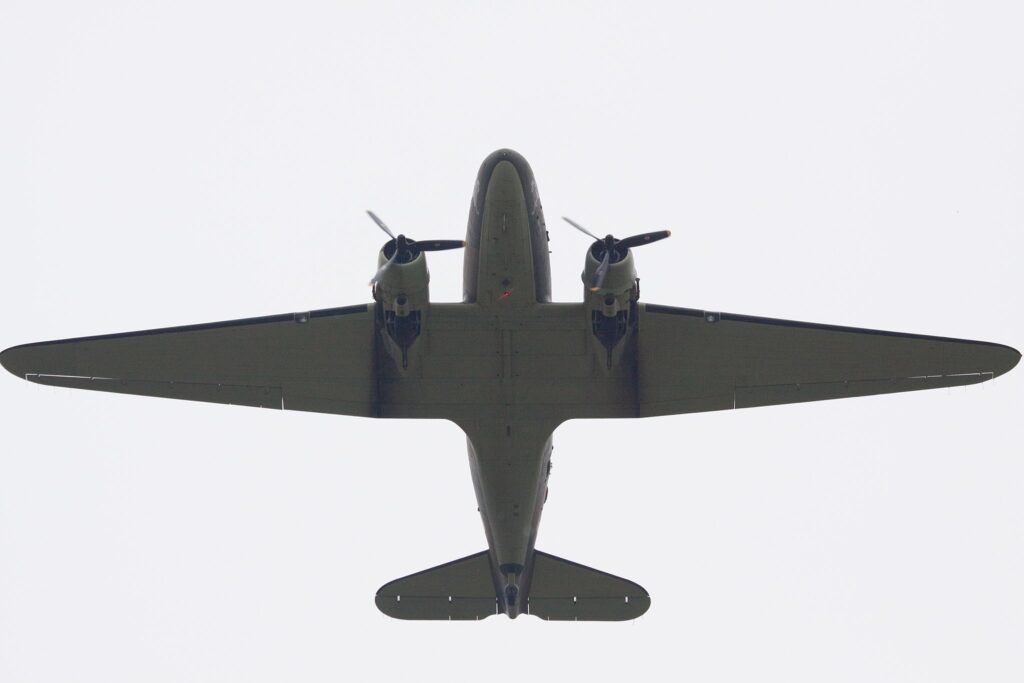
June 1945 saw the last few days of 233 Squadron at Blakehill Farm. WC Mellor flew KG313 on a petrol delivery to B160/ Copenhagen on June 4th before transiting to B156/ Luneburg to collect 25 Displaced Persons bound for B56/ Brussels. Returning to Blakehill Farm, KG313 was ready for the next day’s operation carrying freight to A54/ Le Bourget under the command of Squadron Leader Mackie. The operations record suggests that KG313 then flew to A65/ Perthes in France to collect spares for return to Waterbeach (other sources suggest that Perthes was not used beyond October 1944). Flt.Lt Hyne DFC took KG313 empty to Hendon on June 7th to collect nine SHAEF personnel bound for Y80/ Wiesbaden. Continuing to R62/ Mengen, 26 ‘expatriated prisoners’ were collected and returned to Northolt via Y78 (possibly B78?).
June 8th was the day that 233 transferred to Odiham and KG313, appropriately in its role as the CO’s aircraft, transferred officers kit to the new base. The Wing Commander was back in command of KG313 on June 12th for a flight carrying 20 passengers from Hendon to B168/ Hamburg. 24 passengers were returned to Tangmere before KG313 landed back at Odiham. The next day, Sqdn Ldr Mackie flew KG313 to the Continent to collect freight bound for Waterbeach. Heading back across the North Sea, 20 passengers were collected for transfer to Blackbushe. WC Mellor flew a similar mission the next day, collecting 27 Displaced Persons from the Continent for transport to Hendon. Returning to B61/ Sint-Denijs, 30 SEAC personnel were collected for a flight to Blackbushe.
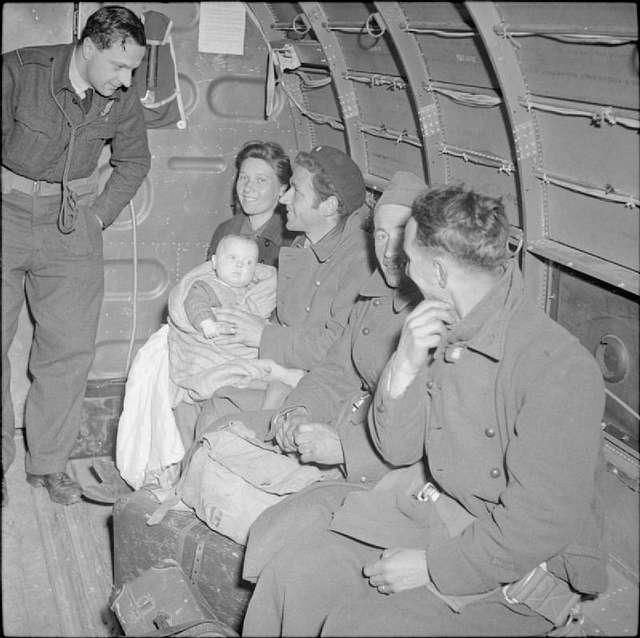
Sqdn.Ldr Mackie’s crew operated KG313 on flights to Hamburg on 17th and 18th June. Fifteen staff from Northolt were flown to B56/ Brussels on 17th, the Dakota continuing to Hamburg before returning to Northolt via B56/ Brussels. On 18th, 5000 lbs of freight was taken from Northolt to B168/ Hamburg and four passengers returned to Northolt. On 19th, PO Wright collected freight from Down Ampney for delivery to B116/ Wunstorf. A tyre and jack were uplifted to B56/ Evere and a return made to Hendon with ex-POWs. The next day Sqdn Ldr Blythe flew KG313 on a series of personnel shuttles from Odiham: Broadwell was visited twice, Blakehill Farm and Down Ampney once each. There seemed to be little carried on these, so the day’s flying may have been partly intended as familiarisation. 26th June saw KG313 flying empty to Hendon with Flt.Lt Hyne at the controls. Passengers were collected from B116/ Wunstorf and another ten returned to Croydon before KG313 landed home at Odiham. WC Mellor reversed the journey the next day, traveling to Croydon to collect 18 passengers for Europe. In Brussels, four stretcher patients and six walking wounded were picked-up for transfer to Down Ampney. Squadron members were on the move prior to a new role for 233 Squadron in India and, on June 29th, Sqdn Ldr Daniell made two flights to Broadwell carrying ten personnel on each trip. Flt.Lt Cheaney captained KG313 on 30th for a passenger flight from Northolt to B156/ Luneburg before returning empty to Odiham via B56/ Brussels-Evere.
KG313’s final days with 233 followed a fairly similar pattern:
FO Smith collected equipment from Boreham on July 1st for the long flight north to Stavanger. On July 2nd FO Smith was again at the controls for a flight carrying aircrew personnel from Fersfield in Norfolk to B77/ Gilze-Rijen, returning empty to Odiham via B56/ Brussels. Wing Commander Mellor may have made his last flight in KG313 on July 3rd when he transferred one passenger to Hendon and collected 18 passengers for Wunstorf, continuing to B56/ Brussels with 25 passengers before returning home empty. On 5th July, Sqdn.Ldr Blythe hopped KG313 to Ibsley to collect six passengers for Berlin. The next sector to B116/ Wunstorf was flown empty and 27 passengers and kit were collected for return to Northolt. 7th July involved another passenger flight from Northolt to Wunstorf with FO Smith in command. Sqdn Ldr Daniell flew KG313 from Odiham to Hendon and on to Gatwick empty before picking-up a load for B14/ detmold and returning via B56/ Brussels and another European airfield.
On July 12th, Flt.Lt Hill was in command of KG313 on, perhaps, her last operational mission with 233. Taking-off at 06:40, the Dakota flew empty to Boreham where 4900 lbs of freight was collected for delivery to Norway. The first call in Scandinavia was Oslo before KG313 continued north to Trondheim and then Bardufoss. Two passengers were returned to the Norwegian capital where 22 Displaced Persons were collected for transport to B56/ Brussels-Evere. The return leg was flown empty.
On July 14th, WC K.Mellor handed over command of 233 Squadron to Wing Commander Banthorpe prior to the Squadron’s transit to India. KG313, which had seemed to be the personal choice of WC Mellor and his predecessors, was flown on a 15 minute air test by PO Butcher on the evening of June 14th, probably ahead of her departure to another unit.
KG313 does not seem to have been one of the batch of 233 Squadron Dakotas which traveled to India and back, delivering the RAF squadron to Imphal and returning with RCAF Squadrons 435 and 436. KG313 is recorded as being transferred to 435/ 436 in the UK but did not return to Canada with them. Instead, she transferred into the State airline system, joining BOAC, probably at Whitchurch, on March 21st 1946.
Civilian Career
The first page of G-AHCT’s entry in the British civil register gives the constructors number 12308 and notes that the Dakota C-47 was ‘A.M KG313’, the ‘AM’ presumably standing for Air Ministry. The initial CofA # 7557 was later scored-out in favour of A-1376. Either way, on 21st March 1946, G-AHCT was registered as a 28-seater monoplane to the British Overseas Airways Corporation at Whitchurch, Bristol (1).
As noted in the history of G-AGYZ, BOAC had been incorporated as the State airline at the beginning of WW2 but was, post-war, to be joined by a State domestic airline, British European Airways. Twenty-four of BOAC’s Dakotas were transferred to BEA (1A) with G-AHCT registered to the new company on 19th August 1946. However, BEA didn’t actually start operations until 31st January 1947 and, in the interim, it seems likely that ‘CT would have flown with Railway Air Services (or another Associated Airways Joint Committee company) in a 20 or 21-seat mode. Once the Dakota had been formally adopted into the BEA fleet, she operated in an all-metal scheme with the BEA ‘Speed Key’ logo on the tail.
(1) Information from the CAA’s database, G-INFO.
(1A) Peter J.Marson, Chapter 8, Vol 3, Air Britain DC-3: The first 75 years, quotes twenty-three BOAC Dakotas being allocated to BEA with twenty actually passing to the domestic airline.

BEA’s first all-freight schedule was operated on August 10th 1947 from Northolt to Brussels and it seems likely that G-AHCT, along with G-AGYZ, was used on freight services. The picture taken by R.A.Scholefield at Ringway in 1951 shows G-AHCT in the same natural metal finish but with ‘Freight Express’ titles added.
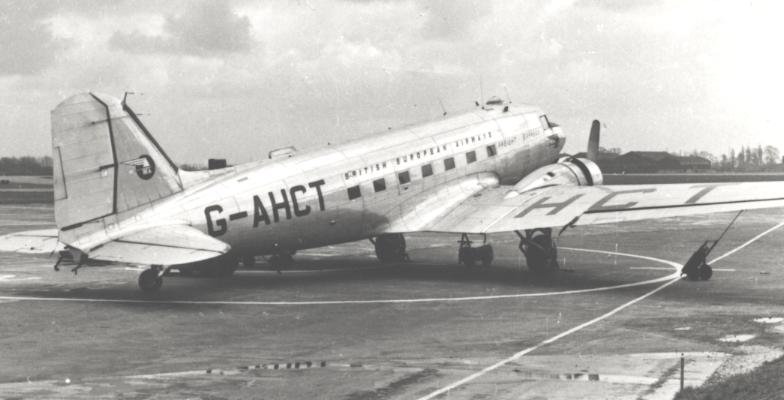
BEA started upgrading their Dakota fleet to ‘Pionair’ status in late 1950 in partnership with Scottish Aviation at Prestwick. In addition to the passenger-configured ‘Pionairs’, which were fitted with airstairs, a further ten Dakotas were modified to ‘Pionair Leopard’ freight specification which retained the double cargo doors. The Leopards received the same avionics upgrades at Field Aircraft Services at Tollerton. G-AHCT was given the fleet name ‘Sir Hiram Maxim’ and served alongside G-AGYZ on European freight routes until March 1954 when both aircraft were sold to Eagle Aircraft Services. The two aircraft were flown to Blackbushe where Eagle up-rated them to Dakota 4s before selling them on to new owners. G-AGYZ joined Airwork on May 6th and G-AHCT is recorded as passing to the Fairey Aviation Group on May 10th 1954 (2).
(2) The Air Britain DC-3 history mentions that, following delivery to Fairey Aviation at their White Waltham base, G-AHCT was briefly leased to the Lancashire Aircraft Corporation during the 1955 summer season. LAC were operating a Dakota fleet on Inclusive Tour flights at this time and may have required extra capacity on their thrice-weekly flights from Manchester to Gatwick and Perpignan or on their nascent coach-air services from Blackpool to Strasbourg and Beauvais. However, a passenger configuration doesn’t seem to be aligned with Fairey’s air survey requirement and, by August 14th 1955, G-AHCT was evident at Elmdon in Fairey titles.
The new owners were a diverse engineering, manufacturing and operating company with a long history dating back to 1915. Their air survey capability had originated in 1923 with the formation of the Air Survey Company of India at DumDum airport, Calcutta. The initial project had been an aerial survey of the Irrawaddy Delta for the Forestry Commission of Burma and that country would furnish many contracts for Fairey Surveys in the years to come. Two Dakotas had already been bought by Faireys: G-ALWC in August 1950 and G-AMCA the following October. The necessary modifications for air survey work included the fitting of camera hatches and this was carried-out by Airtech at Haddenham airfield (3). G-AHCT may also have been converted here before traveling to the Fairey Survey base at White Waltham, an airfield used by the Group for test flying their production aircraft since 1947. Incidentally, White Waltham was the Berkshire airfield which was the Headquarters of the ATA (Air Transport Auxiliary) during WW2.
(3) See www.haddenhamairfieldhistory.co.uk. Some modification for aerial survey work was also carried-out on G-ALWC at Fairey’s Ringway facility.
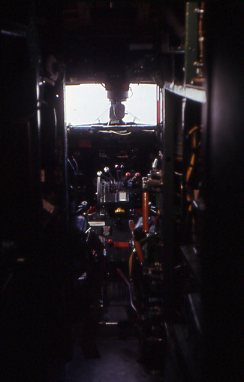
The air survey industry in the 1950s and 1960s benefited from many large contracts for the airborne mapping of countries which had previously been part of the British Empire but were now on the brink of independence. This work was awarded by the foreign-going equivalent of the Ordnance Survey, the Directorate of Overseas Surveys. Hunting Surveys and Fairey Air Surveys were well placed to obtain these contracts as well as UK-mapping and exploration work. Two other companies, , Kemps Aerial Surveys and Meridian Airmaps, did a lot of UK-based work for the Ordnance Survey but less overseas-based projects. Much of the work was in Africa although there were also major projects in the Near East and British Guiana. Fairey’s used Dragon Rapides, an Anson and, occasionally, a Miles Aerovan for work in Europe with the three Dakotas and a couple of DH Doves used on the larger projects overseas.
In March 1956, pilots Pat Cole and Jim Storrie took G-AHCT to the Cameroons with engineer D.Smith and camera operators John Rushton and Cyril Macintyre (4). The crew were billeted in the Government Rest House (possibly in Port Harcourt rather than Douala) while they waited for a break in the almost continuous cloud which precluded high altitude survey. The low level work was completed and, eventually, an 8 hour break enabled the high altitude work to be completed in one mission. G-AHCT then departed for Lagos, where a crew change took place, before the Dakota was flown on to Salisbury, Southern Rhodesia (Harare/ Zimbabwe). Once the project around Salisbury was completed, G-AHCT was flown to the airfield at Bulawayo for work over the Limpopo and Livingston Districts. Upon completion, a further contract was commenced around Salisbury before the Dakota headed north to Kilombero and then Zambesi. This was the last destination before G-AHCT began the journey home via stops in West Africa.
(4) Details from Fairey Surveys house journal ‘Air Surveyor’ as read from the site www.faireysurveys.co.uk.
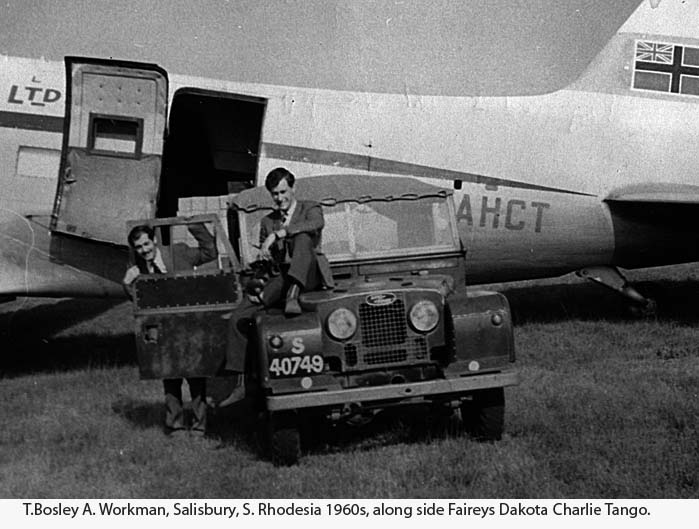
1957 seems to have seen both G-AHCT and G-AMCA working on DOS projects in the same area: Bulawayo, Tanganyika and Uganda with the aircraft flown by Pat Cole and Mike Young. Arriving in Bulawayo in April, Pat Cole’s crew (G-AHCT?) operated at a fair distance from the base and the six hour 30 minute flights offered only quite a short operational period. On the first flight, a loss of radio contact left the base crew fearing the worst and preparing for a full Search & Rescue mobilisation. Fortunately, the Dakota returned safely and continued with the 21,000 square mile survey of Bechuanaland (modern day Botswana) until mid-June 1957. The aircraft then moved to a work area at Arusha, west of Mt.Kilimanjero in Tanganyika. The weather in the vicinity of Mount Meru was poor and the Dakota moved to Nairobi, Kenya. Although it was the dry season, the weather remained cloudy and another move was made, this time to Entebbe, Uganda.
G-AHCT was allocated to a major project for the following year – also one which could have weather limitations. Fairey had signed a huge contract for an eventual total of 200,000 square miles of coverage in Burma to be completed over two dry seasons. The 1958/59 campaign would involve 68,730 square miles of aerial photography, with 35,976 sq.miles at 1:50,000 and 32,754 sq.miles at 1:20,000. Six towns would also be surveyed. The UK office of Fairey would supply G-AHCT and a DeHavilland Dove while the Indian branch of the Company would supply their Dakota, VH-AUI, piloted by Geoff Milsom (4). G-AHCT departed White Waltham in mid-October, clearing outbound Customs at Blackbushe before staging east via Paris and Nice. The aircraft was captained by Martyn Lynch with John Penrose as second pilot and Mervyn Hulland as engineer. Upon reaching Rangoon there was some delay, owing to both fog and Customs, before G-AHCT headed for Myitkyina – an airfield well-known to 233 Squadron Dakotas. As the RAF squadron had found upon their arrival in Burma in August 1945, the weather at the end of the wet season consisted of early morning valley fog building to late afternoon Cu-Nimbus clouds. G-AHCT was scheduled to complete 10,000 sq.miles of 1:50,000 mapping and most was achieved during an 8-day weather window. A six hour 30 minute sortie was flown on Christmas Day 1958. The G-AHCT crew then flew to Mandalay to join the Fairey India Dakota. The British crew’s work was finished by mid-February and G-AHCT departed Mandalay for the UK having shot 37,000 sq. miles using 70 films. The work would continue the following year but with VH-AUI employed.
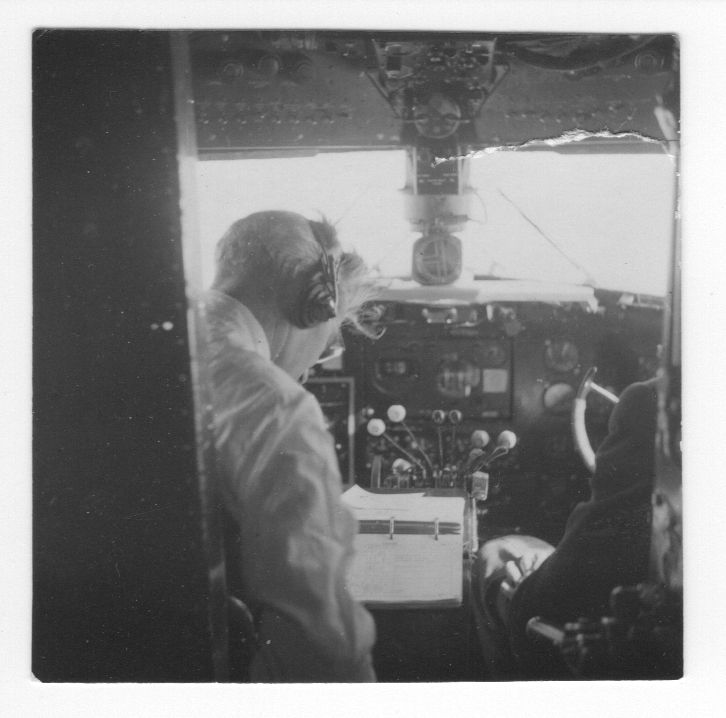
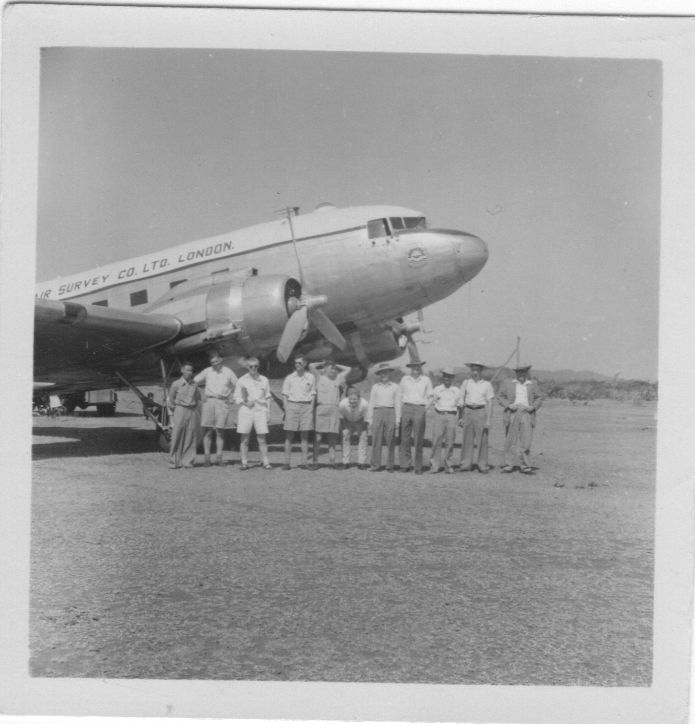
1959 would see G-AHCT back in Rhodesia and Nyasaland shooting a 41,000 sq.mile survey for the Federal Government (of Rhodesia & Nyasaland) based out of Salisbury, Southern Rhodesia. The Dakota arrived back at White Waltham on 4th October 1959.
Uganda would be the destination for G-AHCT during part of 1960. A crew comprising Mike Young and John Penrose (pilots), Tug Wilson, Peter Sharman (camera operator) and Red O”Dell (engineer) covered an 18,200 sq.mile survey before returning to the UK on March 5th 1960. The aircraft carried Fairey’s usual white/ blue colours with a British Civil Air Ensign on a band across the tail fin. Detail is sparse for the rest of 1960 and 1961 but, on June 12th 1962, G-AHCT headed for a new project in Kuwait. Further work in Kuwait cropped-up at the end of 1962 and G-AHCT departed White Waltham for the Middle East on 12th November via a stop at Hurn to clear Customs.
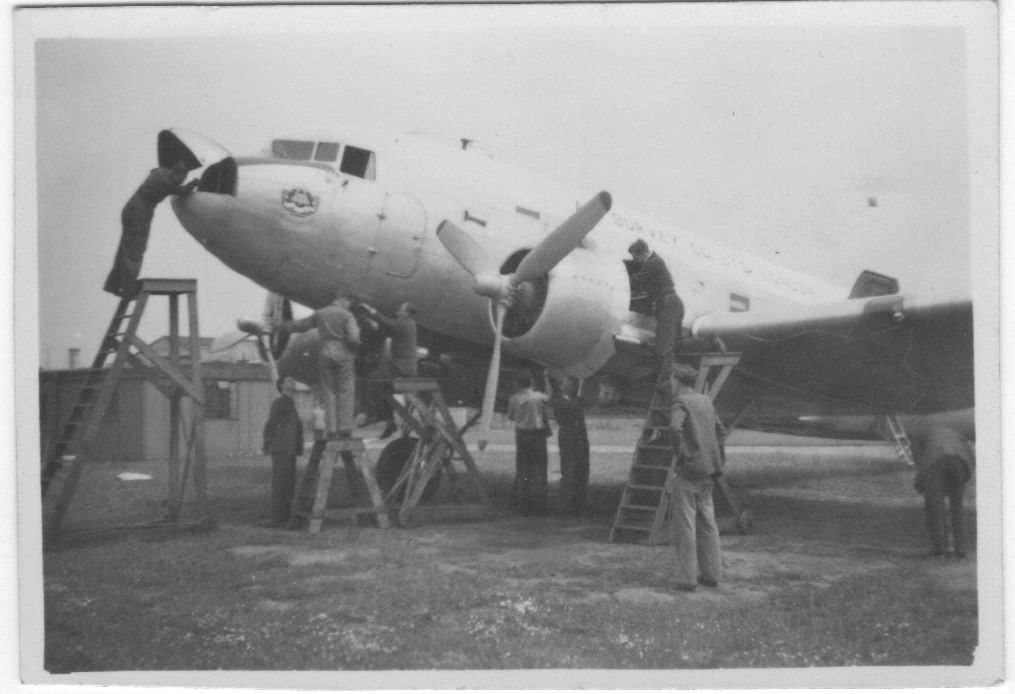
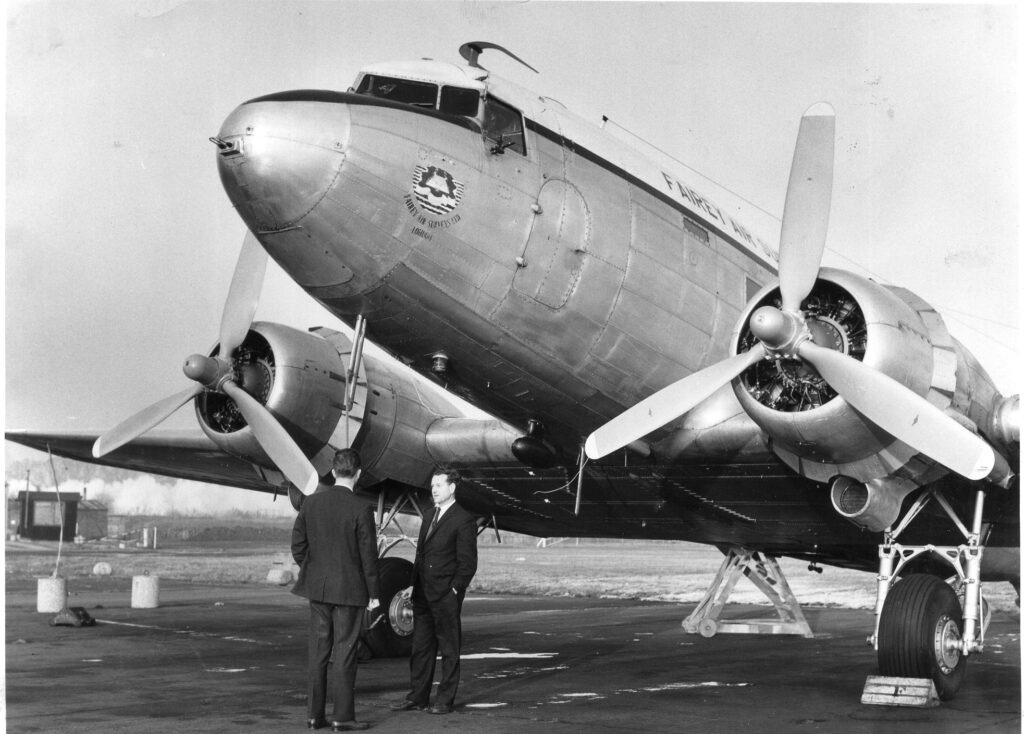
G-AHCT was noted at Malta on 26th/ 27th November 1966 and 17th February 1967 staging through the island en route to/ from foreign projects. In January 1968, Fairey reported that one of their Dakotas was in British Honduras (G-AMCA?), one was engaged in military experimental work and one was being overhauled for a CofA renewal. About this time, G-AHCT was fitted with a new, longer nose at RAE Bedford. The specialised avionics were installed to enable meteorological assessment work with particular interest focused on the height of the tops of thunder clouds. This work may have been carried-out in India as one of the Fairey pilots, Geoff Milsom, reported that the highest thunder cloud measurement was made at 65,000′ over the Bay of Bengal. G-AHCT was noted at Gatwick in June 1969, sporting the longer nose, and was back at White Waltham by 11th July. She flew to Castle Donington on 4th August 1969 but, whether this was for maintenance at Fields or as part of a UK survey project, is unknown.
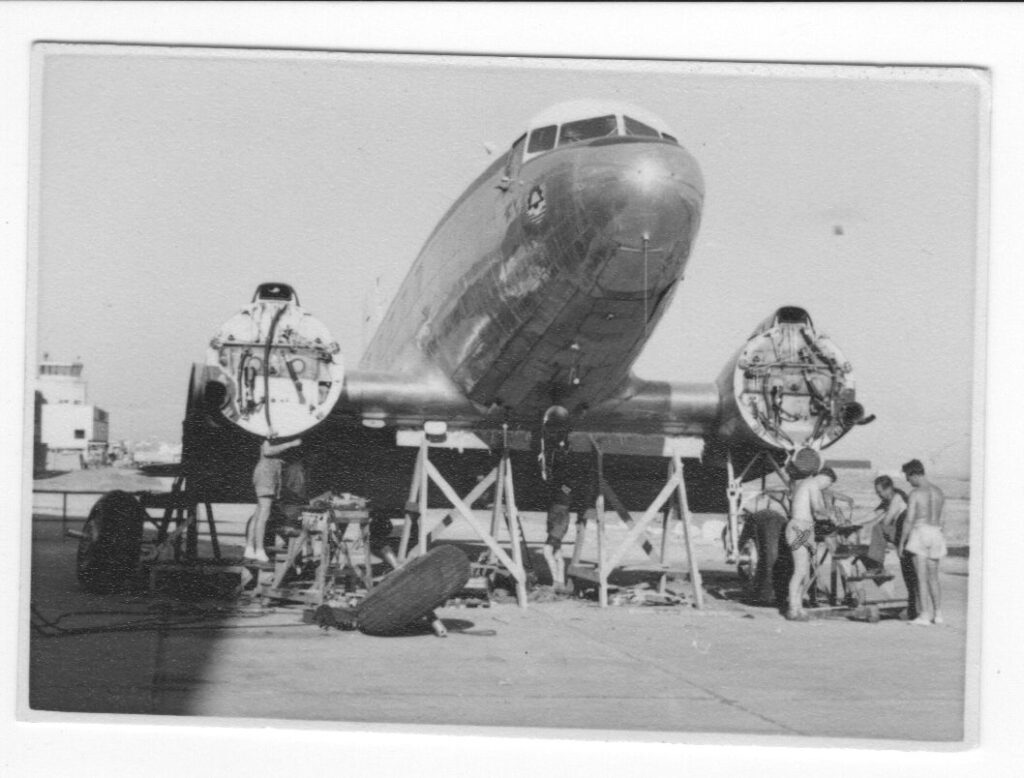
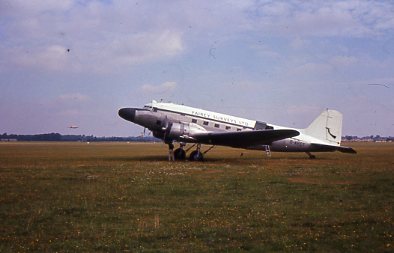
Around 1970, G-AHCT was pictured at Mehrabad, Tehran, possibly while working on an Iranian project. She was also a frequent visitor to Malta in the early seventies with calls on 23/12/70, 27/2/71 and 27/3/71. However, by early 1972, G-AHCT was parked-up at White Waltham and two Beech Queen Airs had been purchased to replace her and one of the DH Doves. Flown to Ringway in February 1972, Fairey Engineering began to dismantle the Dakota to provide spares for G-ALWC and G-AMCA. G-AHCT was officially recorded as ‘withdrawn from use’ on 18th August 1972 and the remaining carcass was donated to the Manchester Airport Fire Service. The sad remains of the WW2 veteran remained in evidence at Manchester Airport’s fire training ground for at least two years, possibly until 1975.
Fairey Surveys was also changing; a new organisation called Fairey Britten Norman Air Services was formed in 1974 but didn’t last long. G-AMCA departed in May 1976 to BST Aviation Holdings of Farnborough, on its way to Air Atlantique the following year. G-AMCA continued to work on air survey charters on a sporadic basis with Air Atlantique.
Eventually, Clyde Petroleum purchased Fairey’s survey operation and, in 1980, incorporated it into Clyde Surveys with G-ALWC and the Queen Airs rebranded appropriately. Clyde was well-known for land survey work, leisure maps and dimensional control work. As such, it operated at an arm’s length from the main business of Clyde Petroleum and the survey organisation was sold on to the engineering consultancy group, Halcrow. The air survey business continued to operate under the Clyde Surveys name and remained based at Fairey’s old offices in Maidenhead. G-ALWC departed in November 1982, eventually joining the French register as F-GBOL and currently preserved in Toulouse. By the mid-1980s, only one Queen Air remained and the flying unit was closed in April 1990.
Hits: 127
